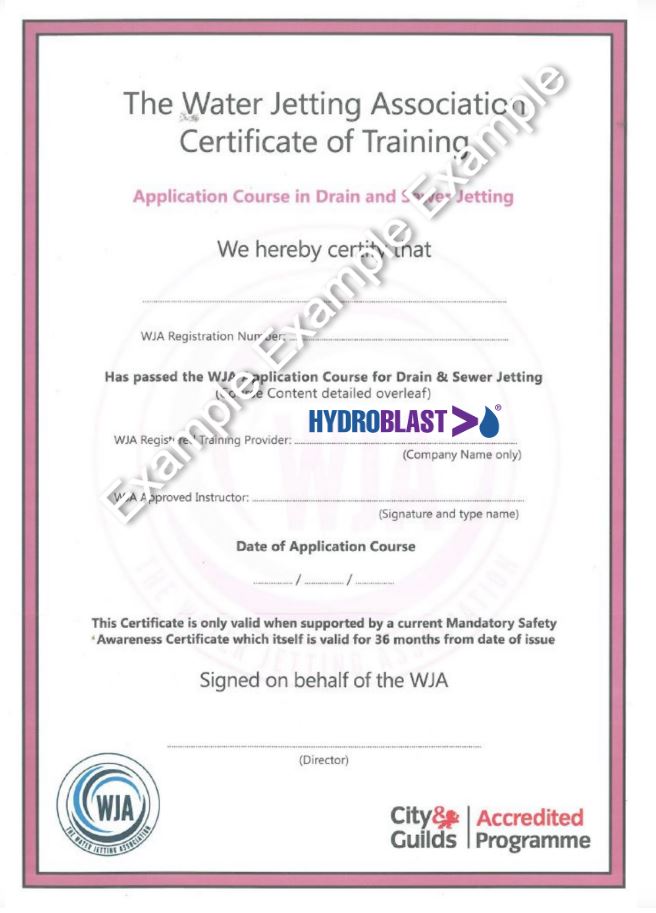Drains and Sewers
Contact usThe Water Jetting Association (WJA) Approved Drains and Sewer Cleaning Course
Who is the course for?
The Drains and Sewer Cleaning Course gives the participant a full appreciation of problems that may be encountered in drains and sewers together with the methods to resolve these using the correct pressures, nozzles and accessories to ensure that the task is carried out safely, competently and efficiently. This theoretical session is concluded by the completion of a questionnaire.
Participants then move outside to complete the practical part of the course. Completion of the practical session is included in the overall pass.
Certificates are issued to those participants who reach the required standard. This course does not need to be revalidated. However, to be valid it must be accompanied by and current valid Safety Awareness Certificate and Photocard.
Are there any prerequisites?
Participants must hold a current valid Safety Awareness Certificate and Photocard issued by the WJA.
What is involved?*
This is a two-part course covering all the main areas of drains and sewer cleaning consisting of theoretical classroom based and practical hands on training. At the end of the theoretical element there will be a question paper with 20 questions with a pass mark of 75%.
Once the course has been successfully completed participants will be issued with a Certificate and photocard which are valid for three years and are issued by the Water Jetting Association (WJA). The Certificate and Photocard are recognised by the Health and Safety Executive (HSE) and are City and Guild Accredited (C&G). These are valid for three years and the course must be repeated before the Certificate and Photocard can be renewed. Please note – If your Safety Awareness certificate goes out of date, for any reason, your other certificates immediately become invalid. A valid Safety Awareness certificate is required to keep all certificates validated.
Example of the Drain and Sewer Cleaning Certificate and Photocard issued by the WJA on successful completion of the course. This certificate only has to be taken once and it remains valid as long as a valid Safety Awareness Certificate is in force.


*WJA Drain and Sewer Cleaning Course – Contents
- Registration and Introduction
- Review Key Safety Awareness Issues
(to be included only when presented as a ‘Stand-Alone’ Course)
Nozzles & Jets, Pumps & Ancillaries, Pressure Controls, High Pressure Hose, Hazards & Injuries, Personal Protective Equipment, Operational Procedures.
- Applications and Machines
Scope of drain and sewer cleaning applications; other pipeline systems. Range of cleaning requirements and standards. Range of Jetting Machines suitable for drain and sewer cleaning.
- Jetting Equipment – Nozzles and Ancillaries
Review nozzle principles – fixed jet nozzles, rotating nozzles, life and wear characteristics, driven rotating nozzles, associated ancillary equipment.
- Jetting Equipment – High Pressure Hose
Hose used in drain and sewer applications, damage and wear possibilities, hose ancillaries. Bore size and flow capabilities.
- Jetting Equipment – Machines
Range of jetting machines used, engine controls and instruments. Pump pressure controls, review dump/dry shut and selector/fail safe types, pressure safety relief. Water supply/delivery features – filtration requirements, boost feed pumps, built-in anti-freeze provisions.
- Job Assessment and Planning
Information and assessment – site location, access to and layout of pipeline; construction material and nature of contaminants – initial condition and require finished condition; water provision, waste disposal, hazards. Selection of equipment & manning levels – jetting machine/nozzles/accessories, number and duties of operators, single person operation. Determine job method, based on safe system of work.
- Operational Procedures
Daily checks – manufacturer’s instructions, other items requiring regular checks. Setting-up – permits/authorisations, barriers and warning signs, positioning of machine and equipment, team duties and signals, flushing, leaks check, preparation for entry of nozzle. Nozzle entry and advance into pipe; control and monitoring during cleaning, debris extraction, standard of finish. Release of hose if trapped by debris, removal of nozzle on completion. Job completion – client inspection, waste removal, equipment decontamination, return site to safe condition.
- Practical Exercises
Jetting machine and equipment – review features, and demonstrate daily checks, start/run/stop. Job assessment – review and discuss, site location and constraints, accessibility, pipeline layout and features. Pipe construction, nature of contamination, required finishing condition. Water supply, effluent drainage and waste disposal. Hazards and use of PPE. Discussion of options agree job method. Site preparation – setting up work area. Team talk – review job method, signal, set up team(s). Position jetting machine, layout and check equipment. Demonstrate all procedures to full group. For all teams, instruct each operator in each duty. Trainees carry out exercise, each team following instructions to set up, flush, check for leaks, prep for nozzle entry, proceed with operation. Rotate team members through duties. Review at each rotation and final review. Disconnect equipment and clear site.
- Summary
Review of course content as above, with opportunity for any further discussion before Questionnaire.
Get in Touch…
Contact us today to learn more about our Water Jetting Training Services. You can also book our open courses online, simply select your preferred date on our calendar.
